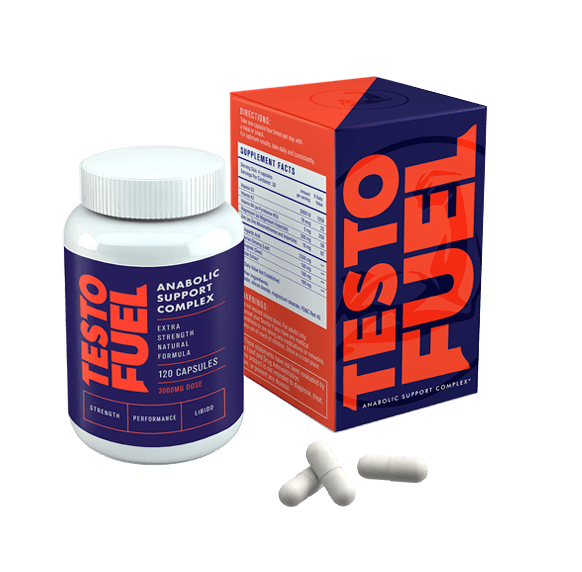
Want to know more about the difference between natural testosterone and anabolic steroids? Check out this detailed guide about the differences between testosterone and steroids.
Flowing through your body right now are hundreds of different hormones. They all have their own individual jobs but work together in concert to optimize both your health and your physique.
In the right levels, these hormones keep you lean, strong and assertive. But if any of them stray from normal levels, a beach-ready physique is impossible to achieve.
In this guide, we’re going to break down the science of natural testosterone and how it differs from anabolic steroids.
What is testosterone?
If you’re a regular gym-goer, you’ll no doubt have heard of testosterone.
It’s a powerful, natural steroid hormone that supports muscle growth. Once puberty kicks in, both men and women can take advantage of this powerful anabolic – stripping down fat and building athletic and strong muscle.
Normal levels for men are between 300-1,000 ng.dL and for women it’s around 10-15 times lower – 25-70 ng.dL.
When levels of this circulating androgen are normal, it provides several health and athletic performance benefits. Here are just a few:
- Increased strength, muscle and bone mass
- Lower levels of body fat – especially belly and chest fat
- More confidence, assertion, and aggression
- Optimum endurance and stamina
- Better sex drive and higher libido
- Lower risk of obesity, diabetes and heart disease
- Better mental health – decreased risk of depression and anxiety
It’s all natural and a completely normal part of your hormonal balance (regardless of whether you’re a woman or a man).
When levels are lower than they should be, all of these benefits disappear. You find that your fitness and strength is non-existent and you’re at a significantly higher risk of being overweight, low on energy and a shadow of your former self.
Key Point: Testosterone is a natural hormone used by the body to optimize both health and physical performance.

Where is testosterone produced?
This is important.
As knowing exactly how and where this powerful hormone is produced helps to differentiate it from synthetic steroids.
There are three areas that are important when it comes to understanding the journey of how T is produced:
- Hypothalamus
- Pituitary gland
- Gonads
Known as ‘test’ or simply ‘T’, testosterone is a hormone produced in the Leydig cells of your testes if you’re a man. In women, it’s your ovaries, adrenal glands and peripheral tissues that produce testosterone.
But how it’s controlled within that tight 300-1,000 ng.dL is a slightly longer story…
Although produced in the gonads, T is monitored by your brain – specifically, an area called the hypothalamus, which acts like a master computer.
If your T levels are getting low, your hypothalamus sends a message to your pituitary gland (situated below the hypothalamus in your brain) using a hormone called GnRH. Imagine a thermostat that automatically turns up the heat when it gets cold. That’s how GnRH works.
Once the pituitary gland receives this message it takes a run up and propels its own hormone into the bloodstream like a slingshot. This hormone is called luteinizing hormone (LH).
Once LH gets to your gonads, it tells them to dump more T into the bloodstream as levels are getting low. And then to stop concentrations getting too high (remember, the normal upper limit is 1,000 ng.dL), the hypothalamus slows down the release of GnRH and therefore the gonads stop making as much.
In other words, the hypothalamus works hard to keep T levels within a ‘physiological normal limit’.
Why do some men suffer low testosterone?
Although the HPG system works well for most people, it can sometimes malfunction. Age is a good example of this, as most men suffer a 1% or so drop in testosterone each year after 30.
If you’re a man and your T levels drop below 300 ng.dL your doctor will diagnose you with a condition called hypogonadism – clinically low testosterone levels.
Symptoms that come with hypogonadism include:
- Loss of energy, vigor, and libido
- Decreased strength, muscle mass, and power
- Your stamina and endurance disappear
- You begin to put on body fat
- Low mood, depression and increased anxiety
Sometimes, the cause of ‘low T’ can be genetic, due to injury or illness too.
The best cure for low testosterone levels is to stay active, lift weights, eat nutritious food, take a testosterone booster supplement and reduce unnecessary stress (late nights, worry etc.).
Key Point: Testosterone is tightly regulated by a system called the hypothalamic-pituitary-gonadal axis. This series of glands and hormones work hard to maintain normal testosterone levels in your blood.
Is testosterone a steroid?
It really depends on your interpretation of the word ‘steroid’.
Hormones are either classified as peptide or steroid based on the raw materials your body uses to make them.
Peptide hormones are made from proteins.
Technically, testosterone is a steroid as it is formed from cholesterol and contains a sterol carbon ring (testoSTERONE – choleSTEROL.
Testosterone is one of five naturally-occurring steroids alongside these hormones:
- Estrogen
- Progesterone
- Glucocorticoids
- Mineralocorticoids
- Vitamin D is classed as a secosteroid, which means it has steroidal properties (that’s why it’s often included in testosterone booster supplements)
Here’s the difference between natural testosterone and anabolic steroids.
As you know now, testosterone is a natural steroid hormone that your body makes to maintain health and physical performance. When levels are high, you look and feel great. When levels are low, you lack energy, strength, and drive.
The real difference between testosterone and steroids
When people talk about steroids, they’re more often than not talking about anabolic androgenic steroids (AAS) – the stuff you have to take exogenously – you either inject or take as an oral tablet.
AAS aren’t naturally made in your body, they’re created synthetically in a lab. Originally, they were designed as a treatment for men with hypogonadism. But it didn’t take long before bodybuilders and athletes could use them to their advantage.
They have a very similar chemical make-up to natural testosterone, but can do one thing differently…
They can override the upper physiological limit for blood testosterone.
Unlike natural testosterone, steroids can by-pass the hypothalamus and pass through the membrane of the target cell. They rapidly boost T levels by binding to androgen receptors located in the cytofluid of those cells and accelerate protein synthesis – this results in more muscle mass than ‘normal’.
When you put a load of exogenous testosterone into your body, you can surpass your normal levels of T. The dose is what’s called supraphysiological, because it can ramp up T levels way above what your hypothalamus regulates as an upper limit.
The results are more lean mass, greater strength, and libido through the roof.
Key point: Anabolic androgenic steroids are synthetic versions of the testosterone hormone. They are able to rapidly increase circulating T levels by overriding your hypothalamic response.

The dark side of anabolic steroid use
So far it almost sounds kinda cool….
Take steroids, surpass your genetic ceiling and make better gains, right?
Wrong.
There’s a serious dark side of steroids you really need to know.
Here’s a list of just some side effects of AAS use:
- Huge strain on your kidneys, liver, and heart
- Total loss of libido and sex drive
- Mood changes – hyper-aggression, depression and increased risk of suicide
- Severe acne and extremely oily skin
Research on steroid use is pretty frightening.
Studies show that prolonged use of AAS leads to peripheral vascular disease, cardiac muscle growth and decreased contractility of the heart [1].
Additionally, various studies have reported an increase in symptoms of schizophrenia, homicidal tendencies and psychosis [2]. They really mess with your mental health, not just physical.
Nowadays, unless you are prescribed testosterone (often as testosterone replacement therapy), steroids are illegal to buy and sell. If you compete in sports, detection of steroids means a long ban from competition.
They’ve been banned since 1974.
It’s just not worth the risk.
Summary – Is testosterone a steroid?
Not got time to read the full article? Here’s a breakdown of the main points we’ve covered:
- Testosterone is a naturally-occurring hormone made by your gonads. It’s classed as a steroid as it contains a sterol ring structure and is made from sterol lipids.
- Anabolic-androgenic steroids are synthetic derivatives of testosterone. They are used by some bodybuilders and athletes to ‘cheat’ their normal blood testosterone levels.
- There are several, severe side effects from steroid use including heart disease and depression.
- You can boost your testosterone levels by exercising, lifting weights, eating a nutritious diet and taking a natural testosterone booster supplement.
References
- Nieminen, MS et al. Serious cardiovascular side effects of large doses of anabolic steroids in weight lifters. European Heart Journal. 1996; 17: 1576-1583
- Kouri, EM et al. Increased aggressive responding in male volunteers following the administration of gradually increasing doses of testosterone cypionate. Drug Alcohol Depend. 1995 Nov;40(1):73-9.
- World Anti-Doping Agency (WADA). https://www.wada-ama.org/en/who-we-are




Leave a comment
Where did you get your numbers for those “normal” levels???
A little of aren’t we!!
Normal healthy levels for men are 1000-1600 and women can be as high as 500 to 600.
Heck research has established that men need to keep there level about 1000 or higher to prevent falling into a category increased hard decease of 30%.
Hi Cornelis,
Current research agrees that the numbers we have cited equate the normal levels of testosterone in men. 1000-1600 as you suggest are far too high. The numbers we have given span all age groups, which is why there is such a wide scope.
Lol. You are citing the average sick American for normal (reference range). Optimal is nowhere near 300 lmaoooooo